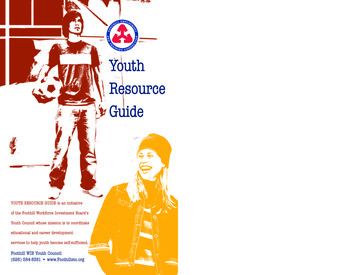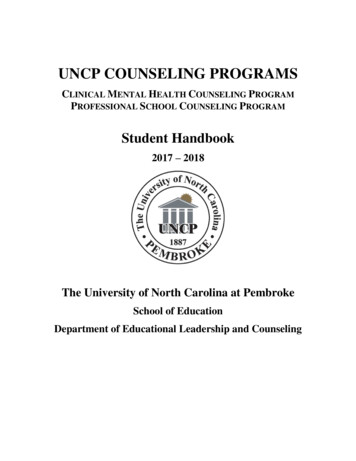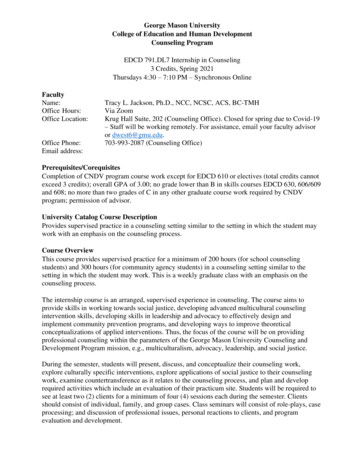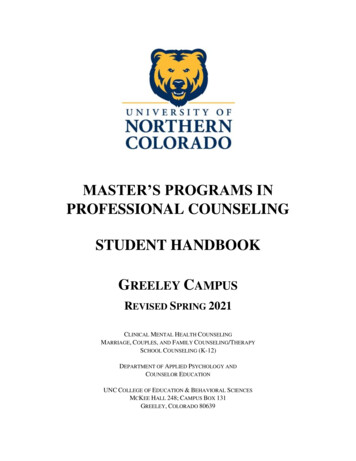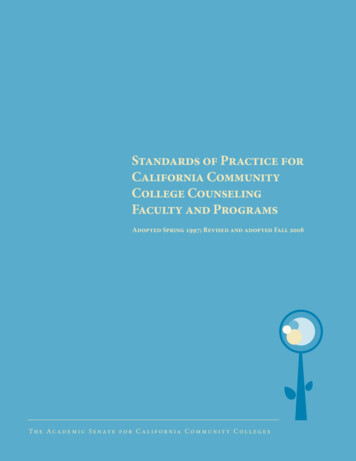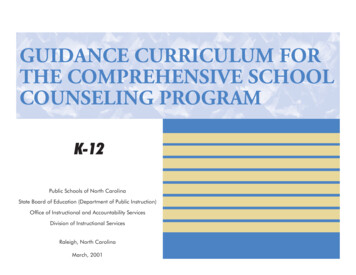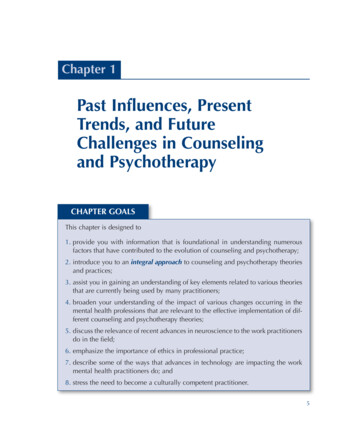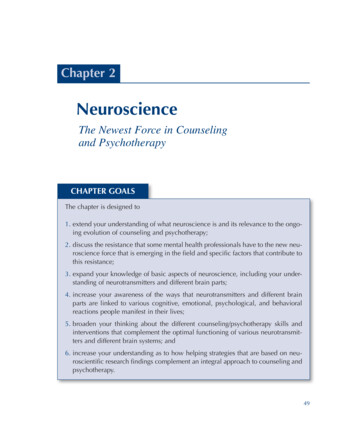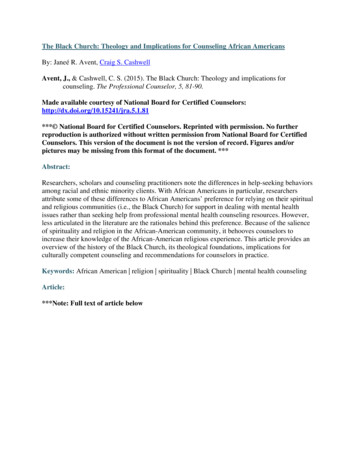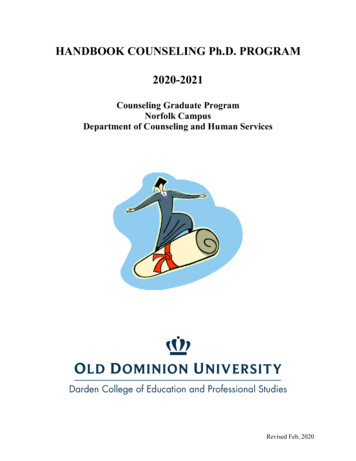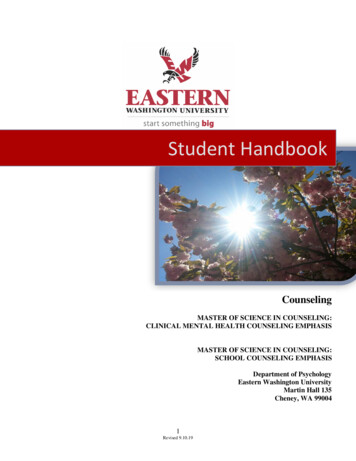
Transcription
Guidance And CounselingDEDU502Edited by:Dr. Kulwinder Pal
GUIDANCE AND COUNSELINGEdited ByDr. Kulwinder Pal
Printed byUSI PUBLICATIONS2/31, Nehru Enclave, Kalkaji Ext.,New Delhi-110019forLovely Professional UniversityPhagwara
SYLLABUSGuidance And CounselingObjectives:To enable the learners to :(1) understand the concepts of guidance and counseling(2) understand testing and non-testing techniques in guidance service(3) understand the types of counseling and qualities of an effective counselorSr. No.Content1Guidance: Meaning, Nature and Scope, Guidance: Goals and Principles, Need forGuidance with Reference to India2Guidance Services: Concept and Importance; Services: Placement Service, Followup Service3Educational and Vocational Guidance ; Organizing Guidance Services at School andCollege Level4Personal and Group Guidance: Concept, Aims and Methods, Personal Guidance atSchool Level and Personal Guidance at College Level5Counseling: Concept, Need and Goals with Reference to India, Counseling:Principles and Counseling Process6Types of Counseling: Directive Counseling, Non-Directive Counseling, EclecticCounseling, Interview Process in Counseling7Counseling Services: Individual Counseling, Group Counseling8Organizing Counseling Services at School Level, Organizing Counseling Services atCollege Level9Psychotherapy: Meaning and Process, Dealing with Psychological Disturbance,Psychotherapy: Cognitive Approach, Environmental Approach ; Counselor: Role andQualities10Testing and Non-Testing Techniques: Psychological Tests, Case Study, RatingScale, Observation, Interview, Inventories, Problems of Guidance and Counselingin India and their Solutions
CONTENTSUnit-1:Guidance: Meaning, Nature and Scope1Kulwinder Pal, Lovely Professional UniversityUnit-2.Guidance: Goals and PrinciplesDinesh Kumar, Lovely Professional University11Unit-3.Need for Guidance with Reference to India21Kulwinder Pal, Lovely Professional UniversityUnit-4.Guidance Services: Concept and Importance32Dinesh Kumar, Lovely Professional UniversityUnit-5.Services: Placement Service, Follow-up ServiceKulwinder Pal, Lovely Professional University43Unit-6.Educational and Vocational Guidance50Dinesh Kumar, Lovely Professional UniversityUnit-7.Organizing Guidance Services at School and College LevelKulwinder Pal, Lovely Professional University72Unit-8.Personal and Group Guidance: Concept, Aims and Methods91Dinesh Kumar, Lovely Professional UniversityUnit-9.Personal Guidance at School LevelKulwinder Pal, Lovely Professional University102Unit-10.Personal Guidance at College Level115Dinesh Kumar, Lovely Professional UniversityUnit-11.Counseling: Concept, Need and Goals with Reference to India122Kulwinder Pal, Lovely Professional UniversityUnit-12.Counseling: Principles and Counseling Process135Dinesh Kumar, Lovely Professional UniversityUnit-13.Types of Counseling: Directive CounselingKulwinder Pal, Lovely Professional University144Unit-14.Types of Counseling: Non-Directive CounselingDinesh Kumar, Lovely Professional University150Unit-15.Types of Counseling: Eclectic Counseling157Kulwinder Pal, Lovely Professional UniversityUnit-16.Interview Process in Counseling162Dinesh Kumar, Lovely Professional UniversityUnit-17.Counseling Services: Individual Counseling176Kulwinder Pal, Lovely Professional UniversityUnit-18.Counseling Services: Group CounselingDinesh Kumar, Lovely Professional University188Unit-19.Organizing Counseling Services at School Level196Kulwinder Pal, Lovely Professional UniversityUnit-20.Organizing Counseling Services at College LevelDinesh Kumar, Lovely Professional University212
Unit-21.Psychotherapy: Meaning and Process228Kulwinder Pal, Lovely Professional UniversityUnit-22.Psychotherapy: Dealing with Psychological Disturbance237Dinesh Kumar, Lovely Professional UniversityUnit-23.Psychotherapy: Cognitive Approach246Kulwinder Pal, Lovely Professional UniversityUnit-24.Psychotherapy: Environmental Approach255Dinesh Kumar, Lovely Professional UniversityUnit-25.Counselor: Role and QualitiesKulwinder Pal, Lovely Professional University264Unit-26.Testing and Non-Testing Techniques: Psychological Tests272Dinesh Kumar, Lovely Professional UniversityUnit-27.Case Study288Kulwinder Pal, Lovely Professional UniversityUnit-28.Rating ScaleDinesh Kumar, Lovely Professional University295Unit-29.ObservationKulwinder Pal, Lovely Professional University300Unit-30.Interview306Dinesh Kumar, Lovely Professional UniversityUnit-31.InventoriesKulwinder Pal, Lovely Professional University314Unit-32.Problems of Guidance and Counseling in India and their Solutions319Kulwinder Pal, Lovely Professional University
Kulwinder Pal, Lovely Professional UniversityUnit 1: Guidance: Meaning, Nature and ScopeUnit 1: Guidance: Meaning, Nature and ScopeNotesCONTENTSObjectivesIntroduction1.1 Meaning of Guidance1.2 Nature of Guidance1.3 Scope of Guidance1.4 Summary1.5 Key words1.6 Review Questions1.7 Further ReadingsObjectivesAfter reading this unit students will be able to: Explain the meaning of Guidance Describe the nature of Guidance Discuss the scope of GuidanceIntroductionGuidance is as old as civilisation. In the primitive society, elders in the family offered guidance tothe young and to persons in distress. Even today, in India, guidance, whether in educational,vocational or personal matters, is sought from family elders. Guidance-unorganised and informal in all places and at all levels has been a vital aspect of the educational process. With the passage oftime, revolutionary changes have taken place in the field of agriculture, industry, business andmedicine etc. These changes in all walks of life coupled with extraordinary growth in our populationhas made the social structure very complex. Head of the family or leader of the community with alimited knowledge of the changed conditions is hardly competent in providing guidance andcounseling to the youth of today. Hence, there is a need for specialised guidance services. In thisunit, we will try to interact with you regarding the meaning and nature of guidance, its need andscope in India.1.1 Meaning of GuidanceIt is true that a very minor percentage of our total population is capable of handling its problemsindependently without the cooperation and guidance of others. We find that majority of the peopledo not have either confidence or insight to solve their problems.There have always been people in the past who need occasional help from older or more experiencedassociates in meeting with their problems of daily life in the society.Traditionally, in our Indian society, the leader of the family or the local community was supposedto provide the necessary guidance and advice whenever any member of the family or the communityLOVELY PROFESSIONAL UNIVERSITY1
Guidance and CounselingNotesneeded it. Needless to mention, too often informal advice given without a clear understanding ofthe problem involved was harmful and misleading to the individual. With the passage of time,revolutionary and evolutionary changes have taken place in all walks, of life. The variety of jobs,high aspirations of the people and vocational specialisation have made the work of guidance verydifficult. The head of the family or the leader of local community with the limited knowledge ofchanged conditions such as globalisation, liberalisation and consumerism is not capable of providingguidance to the youth of today.In the last two decades, guidance movement has spread like a wild-fire through out the world andgenerated a great amount of enthusiasm and zeal among parents, teachers and social workers whohave devoted time to explore its feasibility and the utility for general population including schoolgoing adolescents. All are convinced that proper provision of guidance services should be made forchildren at different age levels for the harmonious development of their personalities in the largerinterest of the society and the individual.What does guidance precisely mean ? Let us first see what it does not mean. Lester.D. Crow andAlice Crow (1962) in “An Introduction to Guidance”, have aptly stated that “Guidance is not givingdirections. It is not the imposition of one person’s point of view upon another person. It is notmaking decisions for an individual, which he should make for himself. It is not carrying the burdensof another life”. If guidance is not all these, then what is it really ?To quote them again: “Guidance is an assistance made available by personally qualified andadequately trained men or women to an individual of any age to help them manage their own lifeactivities, develop their own points of view, make their own decisions, and carry out their ownburden”.Ordinary MeaningGuidance is help, assistance, and suggestions for progress and showing the way. In that senseguidance is a life long process. Man needs guidance throughout his life. He needs it even from hisinfancy. When a child is born, the world for him is big, buzzing, blooming confusion and he knowsnothing. He learns everything from the society. From the mother, he learns how to stand on his feet,from the father, he learns to walk and from the teacher, he learns to seek knowledge and education,all learning takes place through guidance. The society guides the individual to learn, to adjustoneself to the physical and social environment. To sum up we may say that guidance is a personalhelp rendered by the society to the individual so as to enable him to adjust to the physical and socialenvironment and to solve the problems of life.Specific MeaningGuidance in India, is comparatively a new field within the larger and more inclusive field of educationand is used as a technical term as a specific meaning. It covers the whole spectrum of education,which starts from the birth of the child and continues till his death. This is a wide meaning of theterm, which includes all types of education such as formal, non-formal, informal and vocational etc.,which aims to adjust the individual in his environment in an effective way. There are usually threeconnotations attached to the word guidance :1.Guidance as a Specialised Service whose primary concern is with the individual and to helpthem to solve their problems and take appropriate decisions in their choice-points;2.Guidance as a General Service and is considered to be synonymous with education andeducational processes; and3.Guidance as a Sub-Process of education in which developmental needs of the learners areconsidered the basic points.Now let us look at some selected definitions of the term guidance in a bid to understand its conceptualand operational form :2LOVELY PROFESSIONAL UNIVERSITY
Unit 1: Guidance: Meaning, Nature and ScopeThe term guidance represents the concept that is neither simple nor easily comprehensible due tothe complexity of the human nature, the individual differences and personal-social problemsassociated with changing environmental conditions and cultural traditions.NotesShirley Hamrin (1947) defined guidance as : “Helping John to see through himself in order that he maysee himself through”, is a simple and practical but challenging concept of guidance.According to Jones (1951) : “The focus of guidance is the individual not his problem, its purpose is toprovide the growth of the individual in self-direction providing opportunity for self-realisation and self-directionis the key-note of guidance. “Downing (1964) : points out towards a common problem in defining guidance that is one of keepingthe definition short and sufficiently broad to be informative. He has attempted it by giving definitionof guidance in operational terms in two parts :(i)Guidance is an organised set of specialised services established as an integral part of the schoolenvironment designed to promote the development of the students and assist them toward arealisation of sound, wholesome adjustment and maximum accomplishments commensuratewith their personalities.(ii)Guidance is a point of view that includes a positive attitude towards children and realisationthat it is the supplement, strengthen and make more meaningful all other phases of a youngster’seducation.Ruth Strang (1937) : explains that guidance is a process of helping every individual through hisown efforts to discover and develop his potentialities for his personal happiness and social usefulness.Mathewson (1962) : defines guidance as the systematic professional process of helping the individualthrough education and interpretative procedures to gain a better understanding of his owncharacteristics and potentialities and to relate himself more satisfactorily to social requirements andopportunities in accord with social and moral values.Arthur, J. Jones (1963) : thinks that guidance is the help given by one person to another in makingchoices and adjustments and in solving problems.Traxler (1957) : considers guidance as a help which enables each individual to understand hisabilities and interests, to develop them as well as possible and to relate the life-goals, and finally toreach a state of complete and mature self-guidance as a desirable member of the social order.Recently. B.L. Shepherd stated that (1) the immediate objective in guidance is to help each pupilmeet and solve his problems as they arise; and (2) the ultimate objective of all guidance is selfguidance.According to the Secondary Education Commission (1964-66) :”Guidance involves the difficult art of helping boys and girls to plan their own future wisely in the full lightof all the factors that can be mastered about themselves and about the world in which they are to live andwork.“If we analyse the above definitions of guidance, we will find the following elements in it :1.Guidance programme is organised; it has a structure, system and personnel.2.It is an integral part of the school system.3.It consists of specialised sences of testing, counseling, educational and vocational information,placement and follow-up scheme.4.Its major aim is the promotion of student development.5.It helps children to develop and promote their ability to deal with their own problems.LOVELY PROFESSIONAL UNIVERSITY3
Guidance and CounselingNotes6.It provides for the identification and development of talents and potentialities.7.The intangible elements of guidance are recognised as a point of view or as an attitude.Self Assessment:1. State whether the following statements are ‘true’ or false’(i) Guidance is a help and suggestions for progress and showing the way.(ii) Major aim of guidance is the promotion of student development.(iii) Guidance does not develop ability to solve their problems in children.(iv) Guidance is an integral part of the school system.1.2 Nature of GuidanceBy now, you have understood that guidance is a helping service. Guidance is by its very nature aself-oriented, problem solving and multifaceted activity. It presupposes two-fold understanding.The first is the understanding of one’s own abilities, aptitudes, interests, motives, behaviour-patterns,skills and achievements up-to-date and social, cultural economic background. Secondly, it is theunderstanding of the real nature of one’s environment and of the educational and vocationalopportunities offered by that environment, along with their differential requirements of abilitiesand attainments. Guidance may be described as a process of relating these two types of understandingso that they become imbued with a new meaning in the life of the individual.“Guidance seeks to create within the child the need and power to explore and understandhimself in order to prepare a balance-sheet of his assets and liabilities so that is able toplan out his future growth and activities in a manner that offers maximum likelihood ofsuccess and satisfaction. “The following services constitute the usual pattern of activities within a guidance programme andare called ‘basic elements’: Pupil Information or Appraisal Service Educational and Vocational Information Service Counseling Service Placement Service, and Follow-up Service.An effective guidance programme helps the youth to see clearly four things :(i)Where he has been,(ii)Where he is now,(iii) Where he is going, and(iv) What he has with which to get there.A persual of the different activities of guidance shows that two types of guidance, i.e. educationaland vocational, find place in every list. This fact indicates the importance of educational and vocationalguidance. In practice, the entire guidance is a unitary process. Educational guidance is dependenton vocational guidance. Crow and Crow have observed, “As now interpreted, guidance touches4LOVELY PROFESSIONAL UNIVERSITY
Unit 1: Guidance: Meaning, Nature and Scopeevery aspect of an individual’s personality -physical, mental, emotional and social. It is concernedwith all of an individual’s attitudes and behaviour patterns. It seeks to help the individual to integrateall of his activities in terms of his basic potentialities and environmental opportunities”.NotesThese definitions indicate the following aspects of Guidance :(1)Helping people to make wise choices when faced with various alternatives available.(2)Helping people to solve their educational, vocational and personal problems as efficiently aspossible.(3)Helping people to make adequate adjustments in life’s situations.(4)Helping people to develop a more realistic understanding of themselves and their environment.(5)Helping people to know their potentialities, to acquire a knowledge of their level of intelligence,their interest and aptitudes, their self-concepts, values and level of maturity.(6)Helping people to develop their potentialities optimally.(7)Helping people to acquire more reliable information about the world of work.(8)Helping people to contribute their best to the development and welfare of the society.(9)Helping people to live a balanced and tension free-life with full satisfaction under thecircumstances.(10) Helping people to satisfy their needs most effectively and efficiently in most desirable way.(11) Helping people to bring excellence in their according their abilities and potentialities.Guidance is accepted as individualized help. Through the guidance an individual’spersonal development is provided a direction and not to a group. Hence, it is a processof individualized assistance.Guidance As a ServiceGuidance is one of the student personnel services which are getting important day by day. Studentpersonnel services are non-instructional and non-administrative functions of the school. The classroomteaching and the administrative functions of the Principal are not considered student personnelservices. These services are unique in nature and are provided to the students on individual orgroup basis. These services are provided to all categories of students such as talented, gifted andwell adjusted on the one hand and retarded dull handicapped and problems children, on the other.According to Lefever, Tussel and Weitzil, “Guidance is an educational service designed to helpstudents make more effective use of the school training programme.” Guidance, hence, is an integralpart of pupil activity. A broader opinion about guidance as a set of services is expressed by G. E.Smith who described Guidance as a process consisting of “a group of services to individuals toassist them in securing the knowledge and skills needed in making adequate choices, plans andinterpretations essential to satisfactory adjustment in a variety of area.” These areas may beenumerated as educational, vocational, personal of some other ones which produce problems beforethe individual. Hence, Guidance is a service that is universal and continuous. It is not restricted toschool or the family. It is situational and all pervasive and, is present wherever there are people whoneed help and wherever there are people who give help. The main purpose behind these services isto help the individual make satisfactory adjustment to his environment and thus give a significantaccount of himself.Patterson defined personnel services as those which are provided outside, which are non-instructionalin natural in nature and, which are provided to the individual students on an individual basis.LOVELY PROFESSIONAL UNIVERSITY5
Guidance and CounselingNotesThese services are usually provided by specialised personnel, professionally trained in various fields,rather than by the teacher. A teacher may, however, be exposed to some of these programmes tohelp him rearrange his schedules and manipulate classroom instructional environment in a generalway.(1)As a process: Guidance does not occupy independent place. The chief aim of this process is toassist in the development of an individual keeping in view the social needs.(2)A Continuous Process: Guidance is a process. Here, it is important to point out that the processof guidance never ceases. It remains dynamic. In this process, an individual understands himself,learns to use maximum his own capacities interests and other abilities. He continues his strugglefor adjustment in different situations. He develops his capacity of decision-making. Hence, wesee that it is a non-stop process.(3)Related with life: The process of guidance is related to life. This guidance contributes formallyor informally to life because life experiences both formal and in-formal occasions. A persongets informal guidance from his friends and relatives while formal guidance is sought fromorganised school guidance services and other organised guidance services.(4)Development of Capacities: During the process of guidance the individual is assisted in sucha way that he makes himself enabled to develop his capacities maximum from all angles.Hence, guidance stresses the complete development of possibilities present in an individual.An individual becomes familiar with his real image. Hence, guidance is helpful in selfrealization.(5)Task of Trained Persons: Providing guidance is not the function of all persons because varioustechniques and skill are to be used in it. Everybody does not possess the knowledge of thesame. For this task, trained persons, psychologists and counselors are required. Hence, guidanceis a skill-involved process.(6)Helpful in Adjustment: Guidance helps the person in his adjustment different situations. Thisprocess allows to learn to adjust with different types of problems. In this way, the maincharacteristic of the nature of the guidance is to provide new energy to the demoralised personby adjusting himself in the problematic situation through the process of guidance.(7)Helpful in Developing the Ability of Self-guidance: The nature of guidance also includes thecharacteristic of developing self-guidance in a person with help of guidance process. Thisenables him in achieving self-dependence by searching out the solution of problems of life.(8)No Imposition of One’s View Point: It is also the main characteristic of guidance not to imposeone’/s viewpoint on others. It depends upon the wish of an individual how he acquires benefitby accepting the decision of the guidance worker. It he wishes, he may deny to accept suchdecisions of the guidance workers. Hence, it is not a process of imposing the decisions.(9)Helpful in Preparing for Future: The process of guidance is helpful in preparing a person forhis future. Hence, a person can succeed in preparing himself for future activities. In this way,guidance is a well-wisher of an individual’s future.(10) Guidance as an Educational Service: The nature of guidance also includes educational touch.It has been defined as educational service. The meaning of guidance is explained in the contextof problems occurring in the field of education and in the context of adjustment in the schoolenvironment.(11) Client Centred : Guidance has been accepted as a specialized service. In this form, this processis more client centred. In other words, it is based upon developmental approach.How is “Guidance” a continuous process ?6LOVELY PROFESSIONAL UNIVERSITY
Unit 1: Guidance: Meaning, Nature and ScopeScope of guidance service in schools help to make a satisfactory transition from home to the schoolto diagonose the difficulties in the learning of basic skills, to help them to avoid potential dropoutsto study in schools. To help them understand the purpose and meaning of life to plan for furthereducation.Notes1.3 Scope of GuidanceThe scope of guidance is all pervading. Its scope is very vast in the light of modernisation andindustrialisation and is ever increasing. As the life is getting complex day by day, the problems forwhich expert help is needed are rapidly increasing. The scope of guidance is extending horizontallyto much of the social context, to matters of prestige in occupations, to the broad field of social trendsand economic development. Crow and Crow have rightly quoted,” As now interpreted, guidancetouches every aspect of an individual’s personality-physical, mental, emotional and social. It isconcerned with all aspects of an individual’s attitudes and behaviour patterns. It seeks to help theindividual to integrate all of his activities in terms of his basic potentialities and environmentalopportunities.”Kothari Commission has stressed the need of guidance services in the schools. Regarding scope ofguidance, commission was of the view. “Guidance services have a much wider scope and functionthan merely that of assisting students in making educational and vocational choices. The aims ofguidance are both adjustive and developmental, it helps the student in making the best possibleadjustments to the situations in the educational institutions and in the home. Guidance, therefore,should be regarded as an integral part of education.”The scope of guidance has been increasing with the advancement of science and technology,embracing all spheres of life and providing facilities for it. Therefore, it will be difficult to put afence around it. While discussing the scope of guidance we may think of some specific or specialisedareas of guidance. Even though the guidance programme is addressed to the whole individualstreated as an integral unit. It is possible to classify an individual’s problems broadly into educational,vocational and personal.(1)Educational Guidance: It is a process concerned with bringing about a favourable setting forthe individual’s education and includes the assistance in the choice of subjects, use of libraries,laboratories. workshops, development of effective study habits, evaluation techniques andadjustment of school life with other activities :(2)Vocational Guidance: It is the assistance rendered in meeting the problems :(i) relating to the choice of vocation (ii) preparing for it (iii) entering the job, and (iv) achievingadjustment to it.It also aims-at helping individuals in the following specific areas :(a) making individuals familiar with the world of work and with its diverse requirements and,(b) to place at the disposal of the individual all possible aids in making correct appraisal of hisstrength and weaknesses in relation to the job requirements offered by his environment.(3)Personal Guidance: Personal guidance deals with the problems of personal adjustment indifferent spheres of life. Mainly it works for the individuals adjustment to his social andemotional problems. Jones has put the following aims of personal guidance :(i) to assist the individual gradually to develop his life goals that are socially desirable andindividually satisfying.(ii) to help him to plan his life so that these goals may be attained.LOVELY PROFESSIONAL UNIVERSITY7
Guidance and Counseling(iii) to help him grow consistently in ability to adjust himself creatively to his developing lifegoals.Notes(iv) to assist the individual to grow consistently in ability to live with others so effectively thathe may promote their development and his own worthy purposes.(v) to help him grow in self-directive ability.Thus the goal of personal guidance is self-directive and self realisation.This three-fold division of guidance illustrating its scope should not be taken to form watertightcompartments, but it is more a matter of practical convenience for making the concept clearer. Thereis no real difference among the problems to which the different types of guidance services areaddressed.Mathewson while discussing the focus and scope of guidance programme has very aptly stated thatthe focus of guidance is improving the capability of the individuals to understand and deal withself-situational relations in the light of social and moral values. The scope of guidance operation inschool is to deal with :—personal and social relations of the individual in school.—relation of the individual to the school curriculum, and—relation of the individual to the educational and vocational requirements and opportunities.Self Assessment2. Fill in the blanks:(i) . is a specialised service whose primary concern is with the individual and tohelp them to solve their problems.(ii) According to . “Guidance services have a much wider scope and functionthan merely that of assisting students in making educational and vocational choices.(iii) Personal guidance deals with the personal adjustment to his . and . problems.(iv) The . guides the individual to learn, to adjust on self to the physical and socialenvironment.(v) Guidance in . is comparatively a new field of education and is used as atechnical term as a specific meaning.(vi) Guidance is one of the . which are getting important day by day.1.4 Summary8 “Guidance is an assistance made available by personally qualified and adequately trained menor women to an individual of any age to help them manage their own life activities, developtheir own points of view, make their own decisions, and carry out their own burden”. Guidance is help, assistance, and su
Introduction 1.1 Meaning of Guidance 1.2 Nature of Guidance 1.3 Scope of Guidance 1.4 Summary 1.5 Key words 1.6 Review Questions 1.7 Further Readings Objectives After reading this unit students will be able to: Explain the meaning of Guidance Describe the nature of Guidance Di
